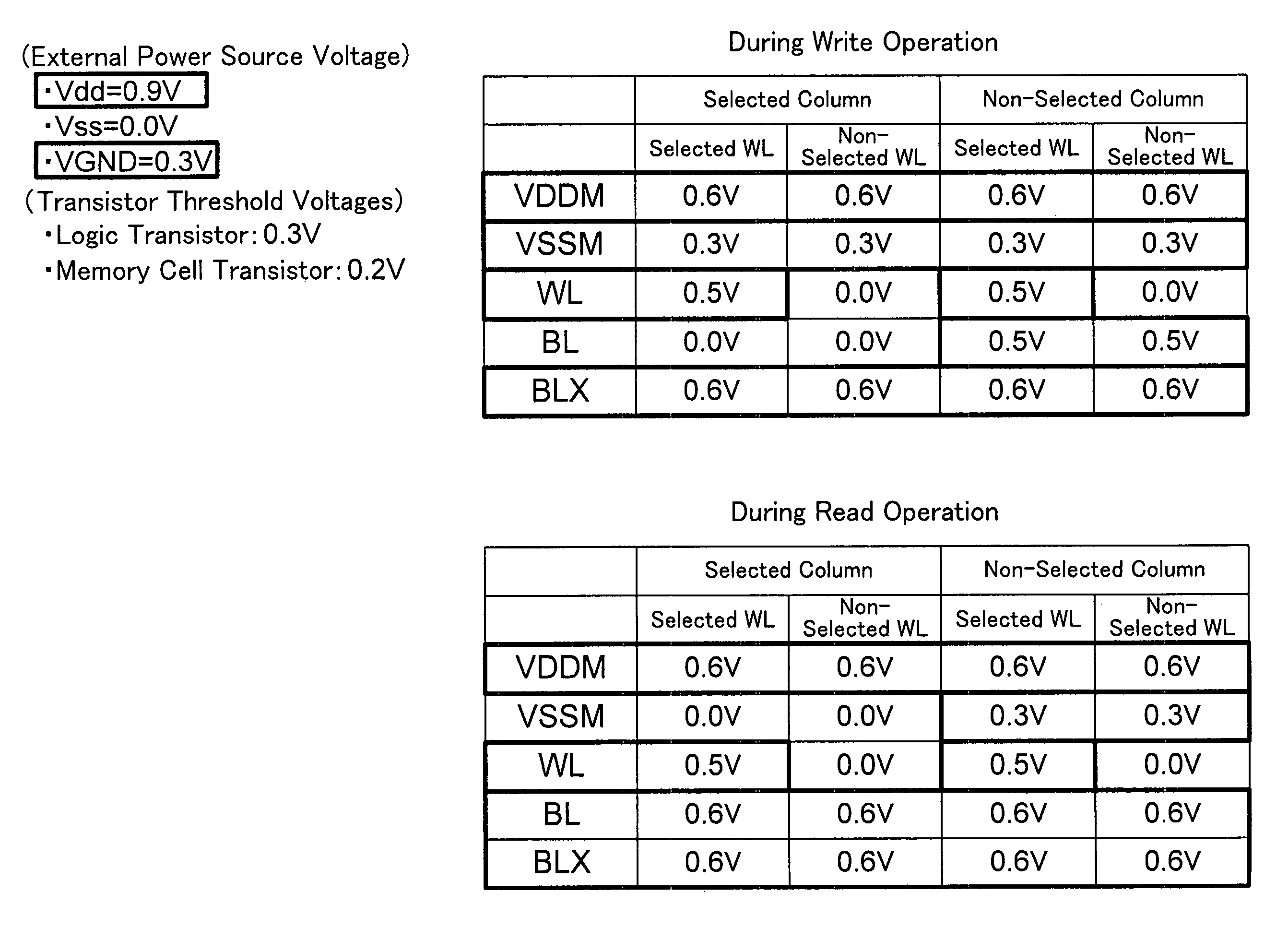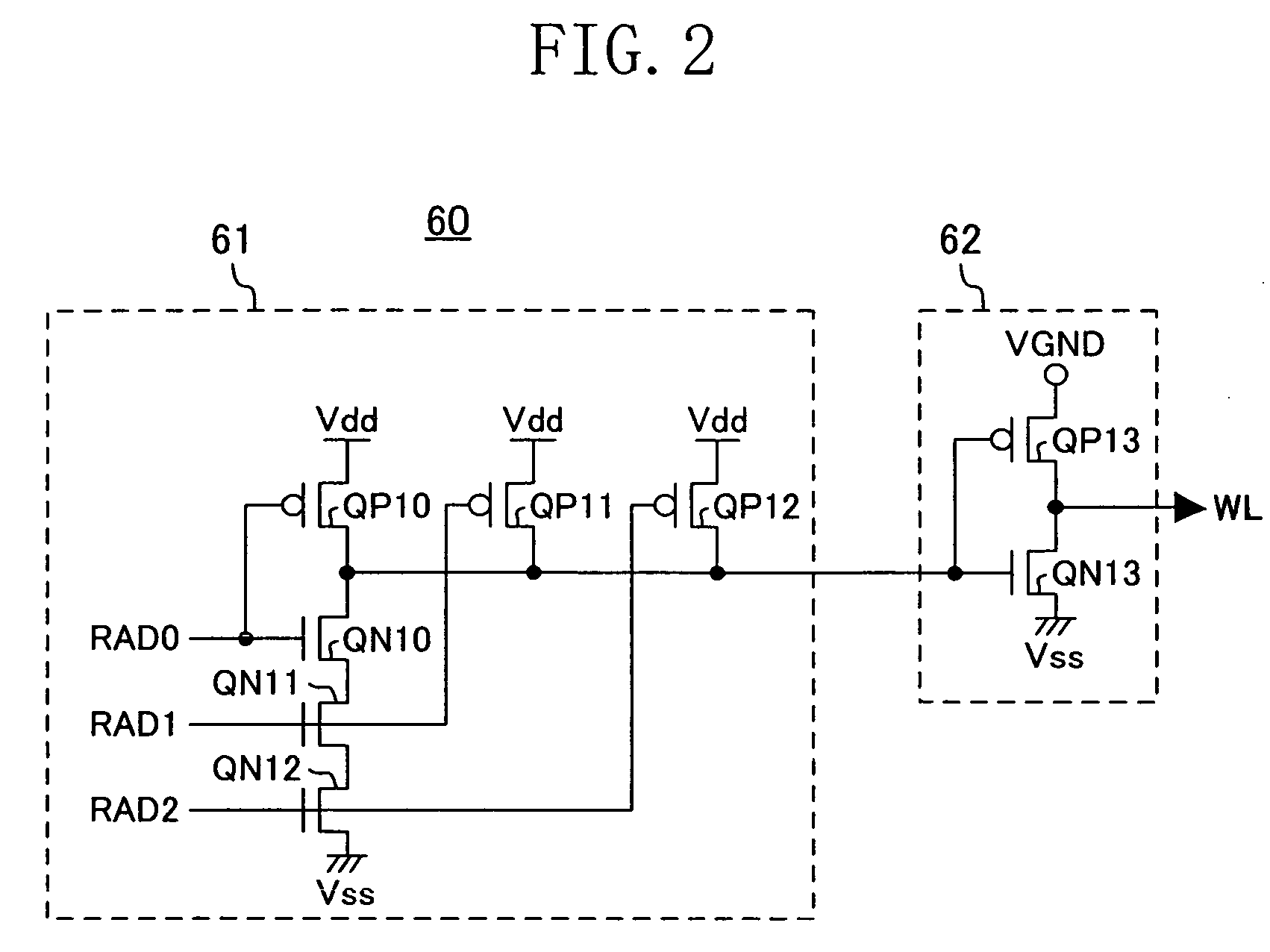Semiconductor memory device
a memory device and semiconductor technology, applied in the direction of information storage, static storage, digital storage, etc., can solve the problems of increasing the margin (static noise margin) for erroneous writing due to bit-line noise or the like, and become extremely difficult to design a memory cell having stable characteristics, etc., to achieve the effect of enlargement of the operation margin of the memory cell
- Summary
- Abstract
- Description
- Claims
- Application Information
AI Technical Summary
Benefits of technology
Problems solved by technology
Method used
Image
Examples
embodiment 1
[0055]A semiconductor memory device 100 according to a first embodiment of the present invention will be described with reference to FIGS. 1 to 4.
(Structure of Semiconductor Memory Device 100)
[0056]FIG. 1 is a block diagram showing a structure of a semiconductor memory device 100. For easier illustration, an output-system circuit such as a sense amplifier is omitted in FIG. 1.
[0057]As shown in FIG. 1, the semiconductor memory device 100 comprises a plurality of Low-data-holding power source control circuits 20, a plurality of bit-line precharge circuits 30, a plurality of write control circuits 40, a memory cell array 10, and a row decoder 50.
[0058]In FIG. 1, WL1 and WL2 denote word lines each routed to extend in a row direction.
[0059]BL1, BL2, BLX1, and BLX2 denote bit lines each routed to extend in a column direction. The bit lines BL1 and BLX form a bit line pair, while the bit lines BL2 and BLX2 form a bit line pair.
[0060]PCG denotes a signal (precharge control signal PCG) trans...
embodiment 2
[0127]Next, a semiconductor memory device 200 according to a second embodiment of the present invention will be described with reference to FIGS. 5 and 6.
[0128]FIG. 5 is a block diagram showing a structure of the semiconductor memory device 200. For easier illustration, an output-system circuit such as a sense amplifier is also omitted in FIG. 5.
[0129]Specifically, the semiconductor memory device 200 has been obtained by replacing the bit-line precharge circuits 30 of the semiconductor memory device 100 with bit-line precharge circuits 210, adding a PMOS transistor QP20, and further changing the threshold voltage of each of the transistors of the memory cells 11.
[0130]The bit line precharge circuits 210 have been obtained by setting the source power source of each of the precharge transistors QP3 and QP4 in the bit-line precharge circuits 30 to the potential VGND (0.5 V). That is, the structure of each of the transistors of the bit-line precharge circuits 210 is the same as the stru...
embodiment 3
[0146]Next, a semiconductor memory device 300 according to a third embodiment of the present invention will be described with reference to FIGS. 7 to 11.
(Structure of Semiconductor Memory Device 300)
[0147]FIG. 7 is a block diagram showing a structure of the semiconductor memory device 300 according to the third embodiment. For easier illustration, an output-system circuit such as a sense amplifier is also omitted in FIG. 7.
[0148]The semiconductor memory device 300 has been constructed by replacing the bit-line precharge circuits 210 of the semiconductor memory device 200 with bit-line precharge circuits 310, replacing the row decoder 50 with a row decoder 320, replacing the Low-data-holding-power-source control circuits 20 with Low-data-holding-power-source control circuits 340, and adding an NMOS transistor QN30.
[0149]The NMOS transistor QN30 is a transistor disposed on the periphery of the memory cell array 10 to generate the potential VGND. The source of the NMOS transistor QN30 ...
PUM
 Login to View More
Login to View More Abstract
Description
Claims
Application Information
 Login to View More
Login to View More - R&D
- Intellectual Property
- Life Sciences
- Materials
- Tech Scout
- Unparalleled Data Quality
- Higher Quality Content
- 60% Fewer Hallucinations
Browse by: Latest US Patents, China's latest patents, Technical Efficacy Thesaurus, Application Domain, Technology Topic, Popular Technical Reports.
© 2025 PatSnap. All rights reserved.Legal|Privacy policy|Modern Slavery Act Transparency Statement|Sitemap|About US| Contact US: help@patsnap.com



